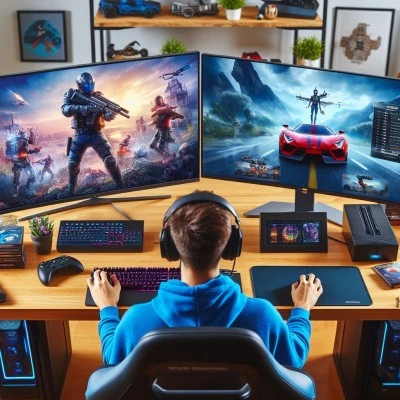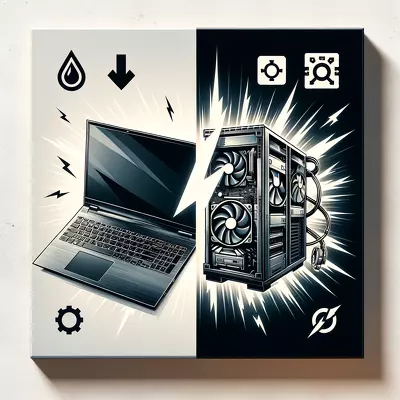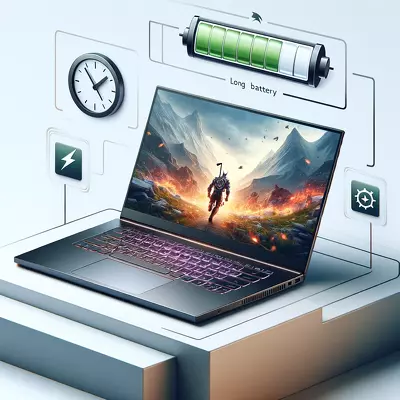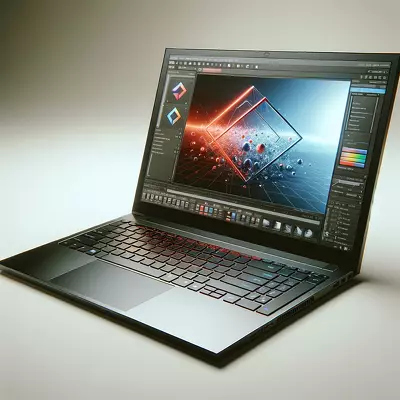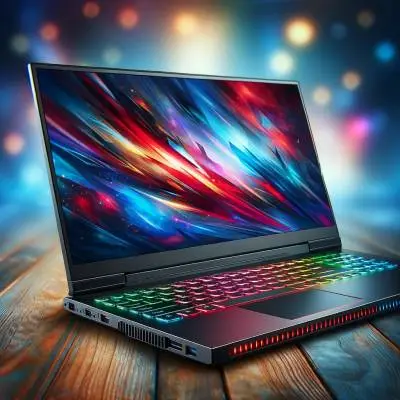The Epic Showdown: PC Gaming on TV vs Monitor
Choosing between gaming on a TV and a monitor presents unique considerations for gamers, ranging from display size and resolution to refresh rates and input lag. Each option offers distinct advantages, whether it’s the immersive experience of a large TV screen or the precision and speed of a high-performance gaming monitor. This article explores these differences to help gamers make an informed decision that enhances their gaming experience.
I. Introduction
The evolution of digital entertainment has significantly transformed the landscape of PC gaming, offering gamers a plethora of options on how and where they can enjoy their favorite games. The choice between playing PC games on a traditional monitor or a television set is one such decision that gamers face today. This article delves into the intricacies of PC gaming on TVs versus monitors, exploring the nuances that define each experience, the factors to consider when choosing between the two, and the advantages and disadvantages inherent to both options.
II. Understanding the Basics
A. Definition of PC Gaming on TV
PC gaming on TV involves connecting a personal computer to a television set, allowing games to be played on a larger screen. This setup is favored for its ability to deliver a more immersive gaming experience, thanks to the larger display size and potential for higher resolution, depending on the television model.
B. Definition of PC Gaming on Monitor
Conversely, PC gaming on a monitor refers to using a computer display specifically designed for personal computing tasks, including gaming. Monitors are typically smaller than TVs but offer higher refresh rates and lower response times, catering to the needs of competitive gamers who prioritize performance and precision.
C. Key Differences
The key differences between PC gaming on a TV and a monitor lie in screen size, refresh rate, response time, and input lag. These elements significantly influence the gaming experience, affecting everything from visual fidelity to gameplay responsiveness.
III. Factors to Consider
A. Screen Size and Resolution
- Impact on Gaming Experience
The size of the screen and its resolution play crucial roles in shaping the gaming experience. Larger screens, such as those provided by TVs, offer a more immersive experience, making them ideal for cinematic games and single-player adventures. However, monitors often support higher resolutions, which can deliver sharper images and more detailed visuals. - Optimal Settings for Each
Finding the optimal settings for screen size and resolution depends on the type of games played and personal preference. For instance, competitive gamers prefer monitors for their higher resolutions and refresh rates, which facilitate better precision and quicker reactions.
B. Refresh Rates and Response Times
- Importance in Gaming
Refresh rate, measured in Hertz (Hz), refers to how many times per second the display updates with new information. Higher refresh rates result in smoother gameplay. Response time measures how quickly a display can change pixels from black to white or from one shade of gray to another, affecting motion blur and image clarity. - Comparison Between TV and Monitor
While TVs have improved in offering higher refresh rates, monitors still lead in this aspect, often reaching up to 240Hz or more, compared to the typical 60Hz or 120Hz found in most TVs. Similarly, monitors usually have faster response times, reducing ghosting and blur in fast-paced games.
C. Input Lag
- Explanation and Why It Matters
Input lag is the delay between performing an action (such as pressing a button) and seeing the result on-screen. It is a critical factor for gaming, as high input lag can disrupt the gaming experience, making it feel less responsive. - How TVs and Monitors Differ
Monitors generally have lower input lag compared to TVs, making them more suitable for reaction-sensitive games. However, many modern TVs come with a ‘Game Mode’ that reduces input lag significantly, making them more competitive for gaming purposes.
IV. Advantages and Disadvantages
A. Advantages of PC Gaming on TV
The most significant advantage of PC gaming on a TV is the larger screen size, which provides a more immersive gaming experience, especially for cinematic and story-driven games. TVs also typically support a wide range of colors and HDR, enhancing visual quality.
B. Advantages of PC Gaming on Monitor
Monitors offer higher refresh rates and lower response times, which are crucial for competitive gaming and fast-paced titles. They also typically feature less input lag and more ergonomic designs, allowing for a more comfortable gaming setup.
C. Disadvantages of PC Gaming on TV
The primary disadvantage of gaming on a TV is the potentially higher input lag and lower refresh rates, which can hinder performance in competitive gaming scenarios.
D. Disadvantages of PC Gaming on Monitor
Monitors may provide a less immersive experience due to their smaller size and lack of the living room integration that a TV setup might offer, making them less ideal for social gaming sessions.
V. Making the Right Choice
A. Considering Your Gaming Style
Your gaming style should guide your choice between a TV and a monitor. If you prefer immersive single-player games or enjoy gaming as a social activity in a living room setting, a TV might be more suitable. Competitive gamers who value performance and precision would likely prefer a monitor.
B. Space and Setup Requirements
Consider the space available and how your gaming setup will integrate into it. Monitors require less space and are easier to position for optimal ergonomics, while TVs might necessitate a more extensive setup.
C. Budget Considerations
Budget can also influence your choice. While you can find both TVs and monitors at various price points, high-performance gaming monitors might come at a premium compared to TVs offering a similar visual quality but with lower gaming performance metrics.
VI. FAQs
Q: Can any TV be used for PC gaming?
A: Yes, but for the best experience, look for TVs with low input lag and high refresh rates.
Q: Do I need a special cable to connect my PC to a TV or monitor for gaming?
A: HDMI or DisplayPort cables are commonly used and support high resolutions and refresh rates.
Q: Is it better to game on a 4K TV or a 1080p monitor?
A: It depends on your preferences and the type of games you play. 4K TVs offer better visuals for cinematic games, while 1080p monitors might provide smoother gameplay for competitive titles.
Q: Can high refresh rate monitors really improve my gaming performance?
A: Yes, they can reduce motion blur and provide a smoother experience, which can be beneficial in fast-paced games.
Q: How does ‘Game Mode’ on a TV work?
A: ‘Game Mode’ reduces processing to lower input lag, making the TV more responsive for gaming.
Q: Is input lag on TVs a deal-breaker for gaming?
A: It can be for competitive gaming, but many TVs now offer acceptable input lag levels for casual gaming.
Q: What’s more important for gaming, refresh rate or resolution?
A: Both are important, but the priority depends on personal preference and the type of games you play.
VII. Conclusion
A. Summary of Key Points
This article has explored the pivotal aspects of PC gaming on TVs versus monitors, highlighting the differences in screen size, refresh rate, response time, and input lag. Each option offers unique advantages, with TVs providing an immersive experience for cinematic games and monitors offering superior performance metrics for competitive gaming.
B. Final Recommendations
When deciding between a PC gaming setup on a TV or monitor, consider your gaming style, the types of games you play, your budget, and how the device fits into your living space. For the best of both worlds, some gamers opt for both setups to enjoy the benefits of each, depending on the game they play.
VIII. Suggested Readings
Before diving into the world of PC gaming, arm yourself with knowledge. Here are a few suggested readings that can provide deeper insights into gaming hardware and strategies:
- “The Master Guide to PC Gaming” – A comprehensive overview of PC gaming, covering everything from hardware selection to optimization techniques. This guide is a must-read for both newcomers and seasoned gamers looking to enhance their setup.
- “Gaming Monitors and TVs: What Every Gamer Needs to Know” – This book demystifies the technology behind gaming monitors and TVs, explaining critical concepts such as refresh rates, response times, and input lag in an accessible manner.
- “PC Gaming Hardware: The Complete Guide” – From GPUs to gaming chairs, this guide covers all the essential hardware needed to build the ultimate gaming setup, offering tips on getting the best performance for your budget.
- “The Gamer’s Guide to Ergonomics” – An essential read for anyone looking to create a comfortable and healthy gaming environment, focusing on the importance of ergonomic practices in gaming setups.
- “Competitive Gaming: Strategies and Secrets” – While not directly related to hardware, this book offers valuable insights into the mindset and strategies of competitive gamers, which can be beneficial when considering the performance aspects of gaming setups.
Exploring these readings can provide a more nuanced understanding of the gaming world, enabling you to make informed decisions about your setup and approach to gaming. Whether you’re a casual gamer looking to maximize your enjoyment or a competitive player aiming for peak performance, the right knowledge and equipment can significantly enhance your gaming experience.
